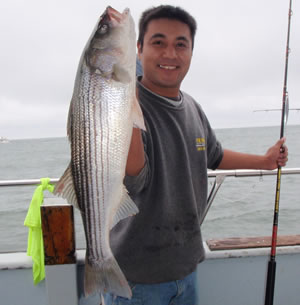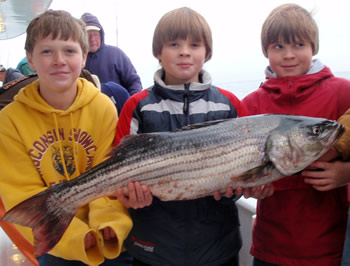2009 Striped Bass Party Boat and Tournament Sampling SummarySenior Biologist October 19, 2010
During two trips in the fall of 2009, 159 fish were measured averaging 27 inches, which was the highest mean length to date. Scale samples were collected from 116 striped bass to determine the age of the fish. Using methods described below, most fish caught on the Queen Mary were age 6 followed by age 5 (Age/Length Key pdf, 36kb). These ages were consistent with previous years where the majority of fish ranged from 4 to 6 years old. Six-year-old fish were from the 2003 year class which coincided with the highest index of New Jersey's Striped Bass Recruitment Survey. The survey has been conducted annually in the Delaware River since 1980 to develop an estimate of relative abundance for striped bass young-of-year. Refer to the article New Jersey's Priceless Resource - Studying the Delaware River on the Division's website for more detailed information about the seine survey. Age Determination Scales are the most common structure used to age striped bass primarily due to the ease of collection without harming the fish. Processing begins with sorting through the scales and placing the best samples on a rectangular piece of acetate (Scales image, top). The acetate is then placed between two thin metal plates and inserted in a heated hydraulic press. Once removed from the press, the scales are removed from the acetate leaving an impression (Scales image, bottom). The slide is then placed in a microfiche reader to determine the age. Using scales to age fish is similar to counting rings on a tree. Click for Scale (age 5) with arrows (pdf, 33kb) pointing to each "ring" or annuli. Although scales are a reliable source of age determination, otoliths (small ear bones located inside the head) are proven to be more accurate especially as age increases. One disadvantage to using otoliths is that the fish must be sacrificed. Two otoliths are extracted from each fish head by removing the bones with tweezers. Once the otoliths are removed they are cleaned and placed in envelopes for processing at the lab. A low speed isomet saw is used to cut a thin slice through the core of the otolith. The cross section is mounted to a slide and viewed with a microscope to determine the age. Like scales, the process involves counting rings. Click to view a processed otolith ready to be aged (taken from Old Dominion University's striped bass ageing protocol by Christina Morgan and Hank Liao). Tagging Ageing with otoliths is not an option during tagging projects or situations where fish are released alive. From 1999 to 2001, scales were collected from 80 fish that were tagged and released aboard the Queen Mary (Tagging Summary Table). Unfortunately, it was determined that tagging was not practical during party boat trips and the numbers tagged were too low to conduct adequate analysis. Eleven of the tagged fish were recaptured generating an overall recapture rate of 14%. Time at large averaged 2.8 years and ranged from 158 days to 5.5 years (Tag Recapture Table). Ironically enough, the fish at large the longest was recaptured in Raritan Bay, not far from where it was tagged over five years before.
TOURNAMENT SAMPLING In addition to sampling aboard the Queen Mary, the Division attended several striped bass tournaments in the fall of 2009. Length and weight were collected from a total of 120 harvested striped bass, averaging nearly 38 inches and 21.5 pounds (Tournament Length Frequency Data). Scales were taken from all striped bass and a subsample of heads were collected from larger fish for otolith extraction at the lab. Using methods described above in the Age Determination section, fish sampled in 2009 ranged from 5 to 15 years with the majority aged at 13 years (Tournament Age Frequency Figure). Age 13 fish were from the 1996 year class which was an above average index from New Jersey's Striped Bass Recruitment Survey and the highest index for Maryland's similar survey on the Chesapeake Bay.
Seashell Striped Bass Derby
South Jersey Big Bass Open
Bay Point Marina Striper Tournament
Like party boat sampling, tournaments are beneficial in supplementing data to the Division's field surveys especially due to the ability for otolith collection. Since fish entered in tournaments are all harvested and are mostly larger fish, it is the preferred sampling method for collecting otoliths.
The Division values any occasion to collect better data and hopes to attend more tournaments in the fall as well as the spring. Thanks again, Tom and Sherry, from the Seashell, to you and your staff for your continued cooperation. Thanks to Kate Nelson from Bay Point Marina, Ken Wente from the South Jersey Big Bass Open and to Fisherman's Headquarters of the LBI Surf Classic for welcoming the Division to attend your tournaments. We look forward to working with all of you again. If any striped bass tournament coordinators are interested in Division staff attending your event, please contact Heather Corbett at 609-748-2020.
|
||||||
|
||
|
|
||
|
||
| |
||


